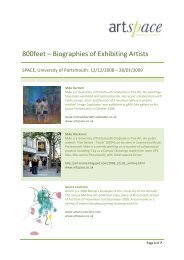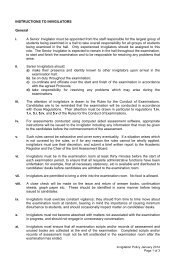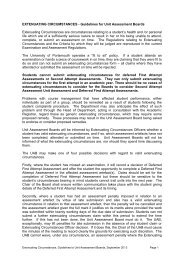Decolonization, the French Empire and sites of memory Dr Robert ...
Decolonization, the French Empire and sites of memory Dr Robert ...
Decolonization, the French Empire and sites of memory Dr Robert ...
You also want an ePaper? Increase the reach of your titles
YUMPU automatically turns print PDFs into web optimized ePapers that Google loves.
<strong>Decolonization</strong>, <strong>the</strong> <strong>French</strong> <strong>Empire</strong> <strong>and</strong> <strong>sites</strong> <strong>of</strong> <strong>memory</strong><br />
<strong>Dr</strong> <strong>Robert</strong> Aldrich, University <strong>of</strong> Sydney<br />
Keywords<br />
anti-colonialism, colonialism, decolonization, <strong>the</strong> <strong>French</strong> <strong>Empire</strong>, <strong>sites</strong> <strong>of</strong> <strong>memory</strong><br />
Q. What was <strong>the</strong> nature <strong>of</strong> <strong>the</strong> decolonization process, 1945–62?<br />
A. <strong>Decolonization</strong> was a painful process for <strong>the</strong> <strong>French</strong>. The wartime leaders <strong>of</strong> <strong>the</strong> Free <strong>French</strong> has<br />
ruled out independence (or even self-government) for <strong>the</strong> colonies, though <strong>the</strong>y promoted a new vision<br />
<strong>of</strong> economic <strong>and</strong> social development through <strong>the</strong> Union Française established in 1946. Many feared<br />
that <strong>the</strong> loss <strong>of</strong> empire would reduce France to a smaller role in world affairs – one president <strong>of</strong> <strong>the</strong><br />
Senate said that with its empire, France was a great power, but without it, France would only be a small<br />
bit <strong>of</strong> <strong>the</strong> European continent. Never<strong>the</strong>less, nationalism <strong>and</strong> anti-colonialism in <strong>the</strong> empire, a changed<br />
<strong>and</strong> increasingly anti-colonial international context <strong>and</strong>, according to some defenders <strong>of</strong> empire, a loss<br />
<strong>of</strong> imperial resolve in France led to a retreat from most <strong>of</strong> France’s overseas possessions.<br />
At <strong>the</strong> end <strong>of</strong> <strong>the</strong> Second World War, France had to quit its Middle Eastern protectorates <strong>of</strong><br />
Syria <strong>and</strong> Lebanon. Soon Vietnamese nationalists launched an attack on <strong>the</strong> <strong>French</strong> in Indochina,<br />
where Paris had only tenuously reinstated its control after <strong>the</strong> Japanese occupation. Ho Chi Minh <strong>and</strong><br />
his forces successfully waged war against <strong>the</strong> <strong>French</strong>, <strong>and</strong> defeat at Dienbienphu in 1954 led to <strong>French</strong><br />
evacuation <strong>and</strong> <strong>the</strong> independence <strong>of</strong> Vietnam – though it remained divided into two countries until<br />
reunification in 1975 – <strong>and</strong> Cambodia <strong>and</strong> Laos. The year 1954 also saw <strong>the</strong> beginning <strong>of</strong> <strong>the</strong> Algerian<br />
war <strong>of</strong> independence, which was particularly difficult <strong>and</strong> violent because <strong>of</strong> <strong>the</strong> opposition <strong>of</strong> one<br />
million pieds-noirs, descendants <strong>of</strong> European settlers, to independence, which was not achieved until<br />
1962. Meanwhile, without such turmoil, <strong>the</strong> <strong>French</strong> had granted independence to <strong>the</strong> protectorates <strong>of</strong><br />
Morocco <strong>and</strong> Tunisia in 1956. In 1958, <strong>the</strong> African colony <strong>of</strong> Guinea opted for independence against<br />
<strong>French</strong> wishes. Two years later, most <strong>of</strong> France’s colonies in Sub-Saharan Africa gained independence,<br />
generally through peaceful means <strong>and</strong> under arrangements by which France hoped to retain its<br />
commercial, political <strong>and</strong> cultural influence. <strong>Decolonization</strong> thus took place in a variety <strong>of</strong> ways – from<br />
a ‘gentleman’s agreement’ with some black African countries to protracted war in Vietnam <strong>and</strong> North<br />
Africa.<br />
The process also had great repercussions in France, especially during <strong>the</strong> Algerian War when<br />
violently opposed views in <strong>the</strong> métropole created great civil strife <strong>and</strong> led to <strong>the</strong> fall <strong>of</strong> <strong>the</strong> Fourth<br />
Republic in 1958 <strong>and</strong> <strong>the</strong> return to power <strong>of</strong> Charles de Gaulle. The end <strong>of</strong> Algérie française also<br />
brought <strong>the</strong> ‘repatriation’ <strong>of</strong> close to a million <strong>French</strong> men <strong>and</strong> women from North Africa, as well as<br />
<strong>the</strong> flight <strong>of</strong> Algerians who had supported <strong>the</strong> <strong>French</strong> cause. This period also saw <strong>the</strong> start <strong>of</strong> <strong>the</strong><br />
increased migration <strong>of</strong> Maghrebin workers to France, many from <strong>the</strong> former possessions <strong>of</strong> North<br />
Africa <strong>and</strong> black Africa. The legacies <strong>of</strong> colonialism, <strong>and</strong> also <strong>of</strong> decolonization, remain important in<br />
present-day France.<br />
Q. How has <strong>the</strong> <strong>French</strong> <strong>Empire</strong> been remembered since 1962?<br />
A. Some people remained defenders <strong>of</strong> <strong>the</strong> old empire <strong>and</strong> denounced what <strong>the</strong>y considered <strong>the</strong><br />
‘ab<strong>and</strong>onment’ <strong>of</strong> <strong>the</strong> colonies. In particular, many pieds-noirs have continued to nurture a cult <strong>of</strong><br />
Algérie française, an idealization <strong>of</strong> what <strong>the</strong>y saw as <strong>the</strong>y homel<strong>and</strong> <strong>and</strong> resentment at <strong>the</strong>ir<br />
dispossession. Many o<strong>the</strong>rs, however, simply preferred to forget <strong>the</strong> empire, especially after 1962.<br />
Colonialism seemed part <strong>of</strong> <strong>the</strong> past, as France focused on new issues – <strong>the</strong> role <strong>of</strong> France in Europe,<br />
social changes, consumer culture, <strong>the</strong> new social movements <strong>of</strong> women <strong>and</strong> o<strong>the</strong>r contestatory groups.<br />
Many preferred not to think or talk about lost colonies <strong>and</strong> an era that receded into <strong>the</strong> past –<br />
colonialism seemed almost as antiquated a topic as <strong>the</strong> old pith-helmets that <strong>the</strong> colonials wore. The<br />
darker sides <strong>of</strong> <strong>the</strong> colonial experience – slavery, <strong>the</strong> use <strong>of</strong> indentured labour, torture, <strong>the</strong> deaths <strong>of</strong><br />
tens <strong>of</strong> thous<strong>and</strong>s <strong>of</strong> <strong>French</strong> soldiers in colonial battles – were banished from <strong>memory</strong>. For a generation<br />
after 1962, except for groups such as pieds-noirs <strong>and</strong> migrants (<strong>and</strong> colonial historians!), <strong>the</strong> <strong>French</strong><br />
suffered from colonial amnesia.<br />
The <strong>French</strong> have now remembered <strong>the</strong> empire. Since <strong>the</strong> 1980s, <strong>and</strong> especially since <strong>the</strong> early<br />
1990s, <strong>the</strong> empire has been rediscovered, sometimes in a haze <strong>of</strong> nostalgia, as illustrated by such films<br />
as Indochine <strong>and</strong> novels including Marguerite Duras’ L’Amant. Colonial motifs appear in interior<br />
design <strong>and</strong> in popular literature, but have also been a new <strong>the</strong>me for historians <strong>and</strong> specialists <strong>of</strong>
cultural studies. Indeed, <strong>the</strong>re is a ‘boom’ in colonial history, with new works on such topics ranging<br />
from colonial photography to colonial prostitution. Anniversaries also have prompted a re-examination<br />
<strong>of</strong> <strong>the</strong> colonial past: <strong>the</strong> sesquicentenary <strong>of</strong> <strong>the</strong> definitive abolition <strong>of</strong> slavery in <strong>the</strong> empire in 1998<br />
inspired renewed concern with this aspect <strong>of</strong> imperial history. The <strong>French</strong>, reluctantly, have had to face<br />
up to controversial <strong>and</strong> distressing colonial issues. The revelations by a retired general, published in<br />
2000, that he had personally carried out acts <strong>of</strong> torture in Algeria in <strong>the</strong> 1950s – <strong>and</strong> his justification <strong>of</strong><br />
such measures in a time <strong>of</strong> war – opened up debate on <strong>the</strong> issue <strong>of</strong> torture. The celebration <strong>of</strong> a ‘Year <strong>of</strong><br />
Algeria’ in France in 2003, however, provided <strong>the</strong> opportunity for publications <strong>and</strong> exhibitions that<br />
examined <strong>the</strong> intertwined history <strong>of</strong> <strong>the</strong> two shores <strong>of</strong> <strong>the</strong> Mediterranean.<br />
Q. What does Pierre Nora mean by ‘<strong>sites</strong> <strong>of</strong> <strong>memory</strong>’?<br />
A. Pierre Nora’s multi-volume collection published in <strong>the</strong> 1980s <strong>and</strong> 1990s <strong>and</strong> translated (somewhat<br />
curiously) as Realms <strong>of</strong> Memory helped create a new field <strong>of</strong> historical research. Lieux de mémoire are<br />
<strong>sites</strong> that are repositories <strong>of</strong> national <strong>memory</strong>, including specific places such as Notre-Dame ca<strong>the</strong>dral<br />
or <strong>the</strong> châteaux <strong>of</strong> <strong>the</strong> Loire Valley, <strong>and</strong> generic places such as <strong>the</strong> café or <strong>the</strong> village church-tower.<br />
They also comprise books, concepts such as <strong>the</strong> ‘Republic’, <strong>and</strong> images <strong>and</strong> icons, key moments in<br />
<strong>French</strong> history (for instance, <strong>the</strong> Vichy regime) or traditional ways <strong>of</strong> underst<strong>and</strong>ing <strong>French</strong> life (an<br />
example <strong>of</strong> which is <strong>the</strong> division between political ‘right’ <strong>and</strong> ‘left’). Some historians have criticized<br />
<strong>the</strong> idea <strong>of</strong> ‘<strong>sites</strong> <strong>of</strong> <strong>memory</strong>’ because <strong>of</strong> this diversity, but o<strong>the</strong>rs find it useful in order to explore <strong>the</strong><br />
history <strong>of</strong> <strong>French</strong> identity in its many, <strong>and</strong> changing, manifestations. Even such ordinary aspects <strong>of</strong><br />
daily life as street names can be examined to look at how <strong>the</strong> <strong>French</strong> underst<strong>and</strong> <strong>the</strong>ir past <strong>and</strong> envision<br />
<strong>the</strong>ir future. ‘Sites <strong>of</strong> <strong>memory</strong>’, even such concrete incarnations, as with statues, are dynamic <strong>and</strong><br />
evolving, testimony to <strong>the</strong> continual re-assessment <strong>of</strong> <strong>French</strong> history, culture <strong>and</strong> identity.<br />
Q. What are <strong>the</strong> colonial <strong>sites</strong> <strong>of</strong> <strong>memory</strong>?<br />
A. During <strong>the</strong> colonial era, <strong>the</strong> authorities tried to imprint colonialism on <strong>the</strong> <strong>French</strong> l<strong>and</strong>scape, in large<br />
part to stimulate fervour for <strong>the</strong> colonial enterprise. Many traces remain in both <strong>the</strong> provinces <strong>and</strong> in<br />
Paris. If you walk around Paris, you can see streets named for explorers such as La Pérouse,<br />
missionaries such as Cardinal Lavigerie, <strong>and</strong> colonial military figures <strong>and</strong> administrators such as<br />
General Faidherbe. You can spot statues <strong>of</strong> <strong>the</strong> colonial great <strong>and</strong> good – <strong>the</strong> bust <strong>of</strong> <strong>the</strong> Mekong<br />
explorer Francis Garnier in <strong>the</strong> Avenue de l’Obsérvatoire <strong>and</strong> General Gallieni outside <strong>the</strong> Invalides. In<br />
<strong>the</strong> Invalides, you can see <strong>the</strong> tomb <strong>of</strong> Marshal Lyautey, one <strong>of</strong> <strong>the</strong> leading colonial statesman, a<br />
military <strong>of</strong>ficer in Indochina <strong>and</strong> Madagascar <strong>and</strong> <strong>the</strong> ruler <strong>of</strong> Morocco. In a Montmartre cemetery,<br />
<strong>the</strong>re is <strong>the</strong> tomb <strong>of</strong> an Orientalist painter, Gustave Guillaumet, decorated with a statue <strong>of</strong> an Algerian<br />
girl. There are also monuments, such as <strong>the</strong> monument to <strong>the</strong> March<strong>and</strong> expedition – which came face<br />
to face with <strong>the</strong> British at Fashoda in 1898 – although, in an act <strong>of</strong> monumental revisionism, <strong>the</strong> statue<br />
<strong>of</strong> March<strong>and</strong> himself was dynamited away in <strong>the</strong> 1970s. Someone taking a colonial tour <strong>of</strong> Paris can<br />
also see <strong>the</strong> buildings <strong>of</strong> empire – <strong>the</strong> old Colonial Ministry, <strong>the</strong> colonial training academy, <strong>the</strong><br />
seminary <strong>of</strong> a missionary society, <strong>the</strong> Paris mosque, residence for colonial students at <strong>the</strong> Cité<br />
universitaire, <strong>and</strong> <strong>the</strong> former colonial museum, <strong>the</strong> old colonial botanical gardens. Each has its own<br />
history, both a colonial history – what it represented at <strong>the</strong> time <strong>of</strong> empire – <strong>and</strong> a post-colonial history<br />
– how it has evolved since <strong>the</strong> end <strong>of</strong> empire.<br />
For instance, in <strong>the</strong> Bois de Vincennes <strong>the</strong>re is a large building erected for <strong>the</strong> 1931 Colonial<br />
Exhibition, <strong>the</strong> ‘Musée Permanent des Colonies’, as it was called. Architecturally, it is a Modernist<br />
structure; <strong>the</strong> outside is decorated with <strong>the</strong> world’s largest bas-belief, portraying <strong>the</strong> benefits <strong>the</strong><br />
colonies gave France, including agricultural products such as tropical fruit, hardwoods, rubber <strong>and</strong> rice.<br />
Inside, <strong>the</strong> auditorium contains murals showing what France gave <strong>the</strong> colonies – justice, medicine,<br />
science. The building is thus a summary <strong>of</strong> colonialist ideology. The museum was renamed <strong>the</strong> ‘Musée<br />
de la France d’Outre-Mer’, when <strong>the</strong> word ‘colonial’ became a ra<strong>the</strong>r old-fashioned nomenclature.<br />
With decolonization, France had no use for a colonial museum, so it was transformed into a museum <strong>of</strong><br />
African <strong>and</strong> Oceanic arts. By <strong>the</strong> 1970s, many <strong>of</strong> <strong>the</strong> rooms with colonialist art were closed to <strong>the</strong><br />
public or used as storerooms, an attempt to hide <strong>the</strong> colonial past. (The outside bas-relief could hardly<br />
be covered up, but a gilt statue <strong>of</strong> ‘La France colonisatrice’ had been moved away from <strong>the</strong> entry.) By<br />
<strong>the</strong> 1990s, <strong>the</strong> museum was trying to re-invent itself with shows on contemporary non-Western art. In<br />
2003, <strong>the</strong> collections were closed, <strong>and</strong> will be sent to a newly-built museum <strong>of</strong> African, Oceanic <strong>and</strong><br />
pre-Columbian American art which will open in <strong>the</strong> Quai Branly. Meanwhile, <strong>the</strong> Palais de la Porte<br />
Dorée, as it is now called, holds temporary exhibitions, <strong>and</strong> its salons historiques (with murals<br />
carefully restored) <strong>and</strong> aquarium remain open to <strong>the</strong> public. From being a confident expression <strong>of</strong>
<strong>French</strong> colonial prowess, it became a embarrassing relic <strong>of</strong> an outmoded belief, <strong>and</strong> now has been<br />
preserved as part <strong>of</strong> <strong>the</strong> colonial patrimony in Paris<br />
There are also anti-colonial <strong>sites</strong>, for example, a plaque along <strong>the</strong> Seine <strong>and</strong> ano<strong>the</strong>r one in a<br />
Métro station that commemorate those who were killed during demonstrations against <strong>the</strong> war in<br />
Algeria. Not surprisingly, anti-colonial <strong>sites</strong> are less prominently marked than ones that are vestiges <strong>of</strong><br />
<strong>the</strong> colonial era <strong>and</strong> its ideology, but <strong>the</strong>y are reminders that <strong>the</strong>re is in France a history <strong>of</strong> anticolonialism<br />
as well as <strong>of</strong> colonialism.<br />
History <strong>and</strong> <strong>memory</strong> are regularly ‘revivified’. The old colonial museum in Paris may have<br />
been closed, but in Marseille, <strong>the</strong> <strong>French</strong> are building a new ‘Mémorial National de l’Outre-Mer’, a<br />
museum <strong>of</strong> <strong>French</strong> overseas expansion (which it will be interesting to compare to <strong>the</strong> British <strong>Empire</strong><br />
<strong>and</strong> Commonwealth Museum in Bristol). In <strong>the</strong> past couple <strong>of</strong> years, President Chirac has dedicated a<br />
memorial to <strong>the</strong> soldiers killed in <strong>the</strong> Algerian War, <strong>and</strong> <strong>the</strong> mayor <strong>of</strong> Paris, Bertr<strong>and</strong> Delanoë, named a<br />
place for Maurice Audin, a ma<strong>the</strong>matician in Algiers who opposed <strong>the</strong> war <strong>and</strong> who was arrested,<br />
tortured <strong>and</strong> killed at <strong>the</strong> h<strong>and</strong>s <strong>of</strong> <strong>the</strong> <strong>French</strong> police. These suggest <strong>the</strong> existence <strong>of</strong> competing, <strong>and</strong><br />
radically different memories, <strong>and</strong> <strong>of</strong> a continued national ambivalence about <strong>the</strong> colonial past.<br />
Finally, <strong>the</strong>re are <strong>the</strong> living ‘<strong>sites</strong> <strong>of</strong> <strong>memory</strong>’: <strong>the</strong> veterans <strong>and</strong> <strong>the</strong>ir associations <strong>and</strong><br />
commemorations, <strong>the</strong> pieds-noirs <strong>and</strong> o<strong>the</strong>rs who had family connections with <strong>the</strong> colonies, <strong>and</strong> those<br />
residents <strong>of</strong> contemporary France who trace <strong>the</strong>ir family origins to <strong>French</strong> overseas possessions. Their<br />
memories <strong>and</strong> mementoes, <strong>and</strong> sometimes <strong>the</strong>ir wounds <strong>and</strong> scars, are also <strong>sites</strong> <strong>of</strong> <strong>French</strong> colonial<br />
<strong>memory</strong>.<br />
Key publications by <strong>Robert</strong> Aldrich<br />
Greater France (Basingstoke: Macmillan, 1996).<br />
‘Putting <strong>the</strong> Colonies on <strong>the</strong> Map: Colonial Names in Paris Streets’, in Tony Chafer <strong>and</strong> Am<strong>and</strong>a<br />
Sackur (eds), Promoting <strong>the</strong> Colonial Idea: Propag<strong>and</strong>a <strong>and</strong> Visions <strong>of</strong> <strong>Empire</strong> in France (London,<br />
Palgrave Macmillan, 2002), pp. 211–23.<br />
Vestiges <strong>of</strong> <strong>the</strong> Colonial <strong>Empire</strong> in France: Colonial Monuments, Colonial Memories (London,<br />
Palgrave Macmillan, forthcoming in 2005).<br />
Fur<strong>the</strong>r reading<br />
Eric Jennings, ‘Remembering “o<strong>the</strong>r” losses: <strong>the</strong> Temple du souvenir indochinois <strong>of</strong> Nogent-sur-<br />
Marne’, History <strong>and</strong> Memory, 15(2) (2003): 5–48.<br />
Patricia A. Morton,Hybrid Modernities: Architecture <strong>and</strong> Representation at <strong>the</strong> 1931 Colonial<br />
Exposition, Paris (Cambridge, MA: Harvard University Press, 2000).<br />
David L. Schalk, ‘Of memories <strong>and</strong> monuments: Paris <strong>and</strong> Algeria, Fréjus <strong>and</strong> Indochina’, Historical<br />
Reflections, 28(2) (2002): 241–53.

















